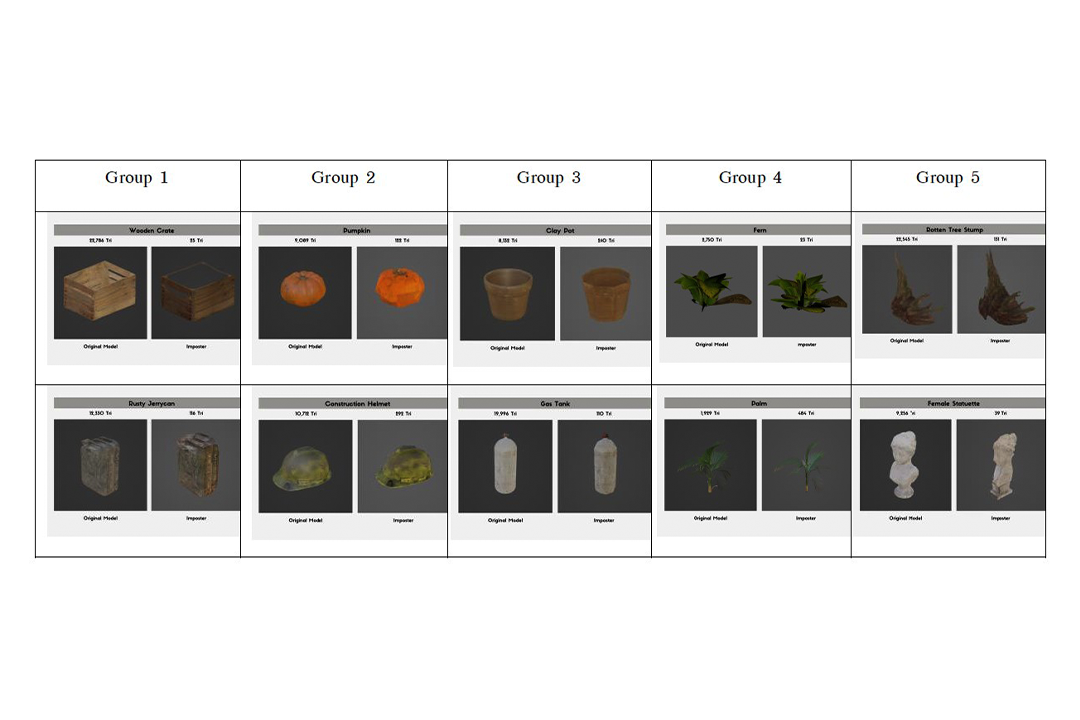The Reduction of 3D Model Polygon by Applying Imposter Technique to Optimize Real-time Rendering of Metaverse in Hubs and Spoke by Mozilla
DOI:
https://doi.org/10.14456/nujst.2023.28Keywords:
metaverse, 3D model, polygon, imposterAbstract
It is crucial for metaverse visualization that users have a shared experience and can interact in real-time over high-speed internet. However, the significant problem is that the amount of geometry artefacts in 3D models affects the effectiveness of processing performance. If the users want a realistic dimensional image, they must use a 3D model with a high polygon, which results in slow processing speed. For these reasons, the main objectives of this research were 1) To have fewer polygons in 3D models than in the original 3D models, by applying the Imposter Technique, and 2) To increase the efficiency of processing 3D models in the Metaverse system which was designed as a workflow that studies the reduction of polygons of a 3D model from High Polygon to Low Polygon by applying the Imposter Technique and inserting the pattern texture of the 3D model per Metaverse users' viewing angles through the Hubs and Spoke of Mozilla. The results showed that decreasing the polygons of the 3D model by applying the Imposter Technique can improve the real-time rendering performance of the Metaverse in the Hubs and Spoke of Mozilla, within the polygon number requirement of not more than 50,000 triangles, with video RAM usage of 256 MB, a file size no bigger than 16 MB, and a framerate at 60 FPS. The results were summarized as percentages. The mean of polygons of all groups' imposter model was 158.2 triangles. The mean of polygons decreased by 98.67%. The mean of the video RAM usage of the imposter model was 42.7 MB, which was a decrease of 73.60%. The mean file size of the imposter model was 4.893 MB with the standard file size reduced by an average of 71.26%, and the maximum copy of imposter at a framerate of 60 FPS of the imposter model was 107.6, an average increase of 365.80%.
References
Amplify. (2022). Amplify Impostors. Retrieved from http://wiki.amplify.pt
Bredikhina, L., Sakaguchi, T., & Shirai, A. (2020). Web 3D Distance live workshop for children in Mozilla Hubs. Retrieved from https://shs.hal.science/halshs-03781969/document
Bruneton, E., & Neyret, F. (2012). Real – time Realistic Rendering and Lighting of Forests. Computer Graphics Forum, 31, 373-382. https://doi.org/10.1111/j.1467-8659.2012.03016.x
Buhalis, D., & Karatay, N. (2022). Mixed Reality (MR) for Generation Z in Cultural Heritage Tourism Towards Metaverse. In: J. L. Stienmetz, B. Ferrer-Rosell, D. Massimo (Eds.), Information and Communication Technologies in Tourism 2022. ENTER 2022. (pp. 16–27) Springer: Cham. https://doi.org/10.1007/978-3-030-94751-4_2
Cipresso, P., Giglioli, I. A. C., Raya, M. A., & Riva, G. (2018). The Past, Present, and Future of Virtual and Augmented Reality Research: A Network and Cluster Analysis of the Literature. Frontiers in Psychology, 9, 2086. https://doi.org/10.3389/fpsyg.2018.02086
Duan, H., Li, J., Fan, S., Lin, Z., Wu, X., & Cai, W. (2021). Metaverse for Social Good: A University Campus Prototype. Proceedings of the 29th ACM International Conference on Multimedia, 20-24 October, 2021 (pp. 1-9). China: Virtual Event.
Hagler, J., Lankes, M., & Gallist, N. (2022). "Behind the Curtains: Comparing Mozilla Hubs with Microsoft Teams in a Guided Virtual Theatre Experience," 2022 IEEE Conference on Virtual Reality and 3D User Interfaces Abstracts and Workshops (VRW), (pp. 19-22). Christchurch: New Zealand. https://doi.org/10.1109/VRW55335.2022.00011.
Misiak, M., Fuhrmann, A., & Latoschik, E. M. (2021). Impostor-based Rendering Acceleration for Virtual, Augmented, and Mixed Reality. 27th ACM Symposium on Virtual Reality Software and Technology (VRST’21), 8–10 December 2021 (pp. 1-10) Osaka, Japan: ACM. https://doi.org/10.1145/3489849.3489865
Munira, A., Jaafar, N. N., Fazilah, A. A., & Nooraizedfiza, Z. (2014). Review on Non Uniform Rational B-Spline (NURBS) : Concept and Optimization. Advanced Materials Research, 903, 338–343. https://doi.org/10.4028/www.scientific.net/amr.903.338
Mystakidis, S. (2022). Mataverse . Encyclopedia 2022, 2, 486-497. https://doi.org/10.3390/encyclopedia2010031
Nevelsteen, K. (2016). Virtual world, defined from a technological perspective and applied to video games, mixed reality, and the Metaverse. Computer Animation and Virtual Worlds, 29(1), e1752.
Nuraliev, F. M., Hamidov, V. S., & Giyosov, U. E. (2020). Placing A Custom 3d Object In The Virtual World Environment. Journal of Advances in Engineering Technology, 2(2), 1-8. https://doi.org/10.24412/2181-1431-2020-2-3-8
Sadiya, S. (2022). Humans Emerging beyond Universe with Metaverse, is it possible? How? International Journal for Research in Applied Science & Engineering Technology (IJRASET) 2022, 1479-1485. https://doi.org/10.22214/ijraset.2022.40044
Sukwinya, K. (2022). A Production of Virtual Reality Technology Learning Materials: Driving for Preparator of Practical Driving License Test. Naresuan University Journal: Science and Technology, 30(1), 1-17.
Tang, Y. M., & Ho, H. L. (2019). 3D Modeling and Computer Graphics in Virtual Reality, Mixed Reality and Three-Dimensional Computer Graphics, Branislav Sobota and Dragan Cvetković. Retrieved from https://www.intechopen.com/books/mixed-reality-and-three-dimensional-computer-graphics/3d-modeling-and-computer-graphics-in-virtual-reality
Trapp, M., & Dollner, J. (2019). Real-time Screen-space Geometry Draping for 3D Digital Terrain Models. 23rd International Conference Information Visualisation (IV), (pp. 281-286). Paris, France: IEEE.
Wang, S., & Zhang , J.(2021). Research and Implementation of Real-time Render Optimization Algorithm Based on GPU. Journal of Physics: Conference Series, Volume 2136, The International Conference on Electronics, Electrical and Information Engineering 2021 (ICEEIE 2021) 13-16 August 2021, Changsha, China
Xu, X., Chen, H., Moreno-Noguer, F., Jeni, L., & Torre, F. (2020). 3D Human Shape and Pose from a Single Low-Resolution Image with Self-Supervised Learning. Retrieved from https://arxiv.org/pdf/2007.13666.pdf
Xia, J. C., El-Sana, J., & Varshney, A. (1997). Adaptive Real-Time Level-of-detail-based Rendering for Polygonal Models. IEEE Transactions on Visualization and Computer Graphics, 3(2), 171-183. Retrieved from https://ieeexplore.ieee.org/document/597799

Downloads
Published
How to Cite
Issue
Section
License
Copyright (c) 2023 Naresuan University Journal: Science and Technology (NUJST)

This work is licensed under a Creative Commons Attribution-NonCommercial 4.0 International License.













